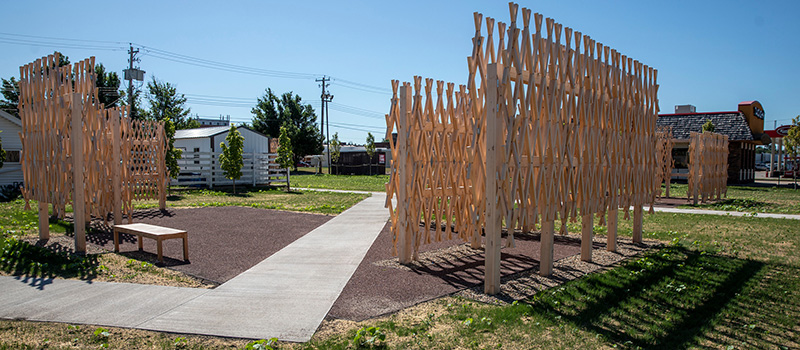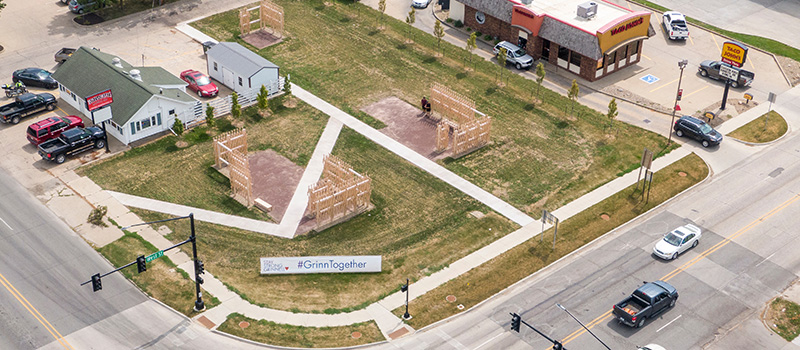New Grinnell Crossroads sculpture intersects College and community
October 06, 2020 — A previously vacant lot at Grinnell’s busiest intersection is now home to a public art piece that crisscrosses memories that tie Grinnell College and the town of Grinnell together.
The Grinnell Crossroads sculpture is the culmination of a four-year process to place something distinctive on the southeast corner of U.S. Highway 6 and Iowa 146 (known locally as Sixth Avenue and West Street) to announce to visitors and residents that they had reached a crossroads that connects the College and community.
The Walter Hood-designed sculpture references homes that once sat at that intersection along with Iowa’s historical buggy barns and covered bridges.
 The Walter Hood-designed sculpture is a composition of wood walls that pay homage to the previous homes located on the lot.
The Walter Hood-designed sculpture is a composition of wood walls that pay homage to the previous homes located on the lot.
“Public art should create both a pleasant environment and an intriguing space to explore,” says Lesley Wright, director of the Grinnell College Museum of Art. “With Grinnell Crossroads, Walter Hood turned a vacant lot into a place of memory, bringing back outlines of the homes that once stood here and reminding us that Grinnell is an intersection of lives past and present.”
The College purchased the empty lot in 2015. The unusual shape and size of it made developing the space problematic. A year later, former Grinnell College president Raynard S. Kington learned about the design work of Hood and invited him to visit Grinnell.
Hood is the creative director and founder of Hood Design Studio in Oakland, California. The studio is a cultural practice, working across art, fabrication, design, landscape, research and urbanism. Hood creates urban spaces – such as traffic islands, vacant lots, and freeway underpasses – that resonate with and enrich the lives of current residents while also honoring communal histories.
When Hood and his team visited Grinnell in fall 2016, they joined students and residents on a series of walks along sidewalks, streets, and alleys.
“I was drawn to these small houses on tree-lined streets, but more impressive and memorable were the buggy barns that fronted onto alleyways where the neighborhood were served,” Hood says in a video he narrated to accompany the project. “Speaking with students, they voiced their differences about the College landscape as opposed to the town landscape and how they were quite distinct. The Grinnell Crossroads sculpture is a mirage of sorts, a reminder of a cultural past where town and gown were inextricably tied together.”
While some Grinnell residents and alumni may remember a crowded gas station on this corner, further research revealed two homes once sat on the lot. Within the park today are the footprints of the two original homes and one carriage house.
“Walter Hood is a strong believer in history as a thread that ties people and places together,” Kington says. “By resurrecting information about the two homes that once sat on our corner, and through his fascination with the ways people pass by and through Grinnell, he wove together an idea for a small park that reminds us of our past, acknowledges the many intersections in our lives, and provides beauty and respite in the present.”
Plans for the project evolved over the past few years. Steel was originally going to be used but a 2018 trade war with China drove the price too high. In spring 2019, Hood proposes a detailed version in Alaskan yellow cedar wood and shifted from a grid to a diamond pattern.
The final design was approved in fall 2019, and last winter fabrication began in San Francisco on the wooden cedar panels and underlying support structure. Site work began in April and was finished this summer.
“We were interested in the tectonic, how the joints and the wood would age, but also how they would come together to form a new signature sculpture,” Hood says. “The sculpture is a composition of wood walls that compose a lattice-like armature that recall the previous buildings spatial and physical settings. They frame. They inscribe. They project light and shadow. They create a new public space at West and Sixth where students and town folk can come together and experience a new landscape.”
 An aerial view taken from a drone shows how the Grinnell Crossroads sculpture fits into the intersection around Sixth Avenue and West Street.
An aerial view taken from a drone shows how the Grinnell Crossroads sculpture fits into the intersection around Sixth Avenue and West Street.
Open to residents and visitors alike, Grinnell Crossroads is a place where people can pause and reflect, and mark a moment in time.
“The corner where highways 6 and 146 cross was a visual and use problem for many years,” says Tom Lacina, Grinnell Area Arts Council arts director. “The process used by Walter Hood and his team to create an inviting and comfortable public art piece at that location successfully engaged members of the community to uncover concepts that reflect the style, size, and history of architecture in Grinnell as a small town on the prairie.”
—by Jeremy Shapiro